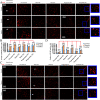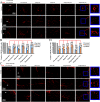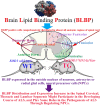Potential effects of brain lipid binding protein in the pathogenesis of amyotrophic lateral sclerosis
- PMID: 37439013
- PMCID: PMC10358493
- DOI: 10.1177/00368504231184320
Potential effects of brain lipid binding protein in the pathogenesis of amyotrophic lateral sclerosis
Abstract
Current studies suggest that the abnormal alteration of brain lipid binding protein (BLBP) might participate in the pathogenesis of amyotrophic lateral sclerosis (ALS). However, the detailed understanding of ALS pathogenesis been yet to be elucidated. Therefore, this research intended to explore the potential effects of BLBP in ALS. The observation and analysis of BLBP-altered features in various anatomical areas and different spinal segments was conducted at the pre-onset, onset, and progression stages of Tg(SOD1*G93A)1Gur (TG) mice and the same periods of age-matched SOD1 wild-type (WT) mice by fluorescence immunohistochemistry and western blotting. BLBP-positive cells were comprehensively distributed in various spinal anatomical areas, especially in both the anterior and posterior horn, around the central canal and in anterior, lateral, and posterior funiculi. Overall, BLBP expression tended to increase from the pre-onset to the onset to the progression stages of the same periods of age-matched WT mice. Furthermore, in TG mice, BLBP expression in the entire spinal cord significantly increased from onset to the progression stage. BLBP was expressed in neurons, astrocytes, and radial glial cells, and at the early and late stages of neural precursor cells (NPCs) and was predominantly distributed outside the cell nucleus. The increase of BLBP-positive cells was closely related to neural cell reduction in TG mice. The distribution and increased expression of BLBP among the cervical, thoracic, and lumbar segments of the spinal cord might participate in the development of ALS and exert potential effects in the pathogenesis of ALS by regulating NPCs.
Keywords: Amyotrophic lateral sclerosis; Tg(SOD1*G93A)1Gur mice; brain lipid binding protein; pathogenesis; spinal cord.
Conflict of interest statement
The author(s) declare that the research was conducted in the absence of any commercial or financial relationships that could be construed as a potential conflict of interest.
Figures







Similar articles
-
Aldehyde Dehydrogenases 1A2 Expression and Distribution are Potentially Associated with Neuron Death in Spinal Cord of Tg(SOD1*G93A)1Gur Mice.Int J Biol Sci. 2017 Apr 10;13(5):574-587. doi: 10.7150/ijbs.19150. eCollection 2017. Int J Biol Sci. 2017. PMID: 28539831 Free PMC article.
-
Altered Features of Vimentin-containing Cells in Cerebrum of Tg(SOD1*G93A)1Gur Mice: A Preliminary Study on Cerebrum Endogenous Neural Precursor Cells in Amyotrophic Lateral Sclerosis.Int J Biol Sci. 2019 Nov 1;15(13):2830-2843. doi: 10.7150/ijbs.33461. eCollection 2019. Int J Biol Sci. 2019. PMID: 31853221 Free PMC article.
-
Perilipin 4 Protein: an Impending Target for Amyotrophic Lateral Sclerosis.Mol Neurobiol. 2021 Apr;58(4):1723-1737. doi: 10.1007/s12035-020-02217-5. Epub 2020 Nov 26. Mol Neurobiol. 2021. PMID: 33242187
-
A candidate protective factor in amyotrophic lateral sclerosis: heterogenous nuclear ribonucleoprotein G.Neural Regen Res. 2023 Jul;18(7):1527-1534. doi: 10.4103/1673-5374.357916. Neural Regen Res. 2023. PMID: 36571358 Free PMC article.
-
Nerve Growth Factor is a Potential Treated Target in Tg(SOD1*G93A)1Gur Mice.Cell Mol Neurobiol. 2022 May;42(4):1035-1046. doi: 10.1007/s10571-020-00993-1. Epub 2020 Nov 24. Cell Mol Neurobiol. 2022. PMID: 33236288 Free PMC article.
Cited by
-
The Role of Fatty Acid Binding Protein 7 in Neurological Diseases.Mol Neurobiol. 2025 May 22. doi: 10.1007/s12035-025-05071-5. Online ahead of print. Mol Neurobiol. 2025. PMID: 40402408 Review.
References
-
- Cozzolino M, Carrì MT. Mitochondrial dysfunction in ALS. Prog Neurobiol 2012; 97: 54–66. - PubMed
-
- Kiernan MC, Vucic S, Cheah BC, et al.Amyotrophic lateral sclerosis. Lancet 2011; 377: 942–955. - PubMed
-
- Kaur SJ, McKeown SR, Rashid S. Mutant SOD1 mediated pathogenesis of amyotrophic lateral sclerosis. Gene 2016; 577: 109–118. - PubMed
MeSH terms
Substances
LinkOut - more resources
Full Text Sources
Medical
Miscellaneous

